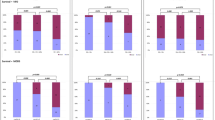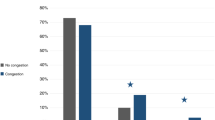Abstract
Acute renal failure (ARF) with fluid overload (FO) occurs often in stem cell transplant (SCT) recipients. We have previously demonstrated that an increased percentage of FO prior to the initiation of continuous renal replacement therapy (CRRT) is associated with mortality in children with ARF. Based on these data, we devised a protocol for the prevention of FO in SCT patients with ARF. SCT patients with ARF and 5% FO were started on furosemide and low-dose dopamine. To allow for nutrition, medication, and blood product administration, RRT was initiated for patients with ≥10% FO. There were 272 patients who received allogeneic SCT from 1999 to 2002. Of these, medical records of 26 SCT patients with a first episode of oliguric ARF were reviewed. The mean patient age was 13±5 years (range 2–23.5 years). Mean days to ARF after SCT were 28±29 days (range 2–90 days). Of the 26 patients, 11 (42%) survived an initial ARF episode. All 11 survivors either maintained <10% FO during their course or re-attained <10% FO with RRT treatment. Of the 15 non-survivors, 6 had <10% FO at the time of death. Of 14 patients who received RRT, 4 (29%) survived. Mechanical ventilation and pediatric risk of mortality score ≥10 at the time of admission to the intensive care unit were associated with lower survival (P<0.05). The use of one or more pressors, the presence of graft-versus-host disease, and septic shock were not correlated with survival. Our data demonstrate that maintenance of euvolemia (<10% FO) is critical but not sufficient for survival in SCT patients with ARF, as all non-euvolemic patients died. We suggest that aggressive use of diuretics and early initiation of RRT to prevent worsening of FO may improve the survival of SCT patients.

Similar content being viewed by others
References
Torrecilla C, Cortes Jl, Chamorro C, Rubio JJ, Galdos P, Dominguez de Villota E (1988) Prognosis assessment of the acute complications of bone marrow transplantation requiring intensive therapy. Intensive Care Med 14:393–398
Jackson SR, Tweeddale MG, Barnett MJ, Spinelli JJ, Sutherland HJ, Reece DE, Klingemann HG, Nantel SH, Fung HC, Toze CL, Phillips GL, Shepherd JD (1998) Admission of bone marrow transplant recipient to the intensive care unit: outcome, survival and prognostic factors. Bone Marrow Transplant 21:697–704
Gruss E, Bernis C, Tomas JF, Garcia-Canton C, Figuera A, Motellon JL, Paraiso V, Traver JA, Fernandez-Ranada JM (1995) Acute renal failure in patients following bone marrow transplantation: prevalence, risk factors and outcome. Am J Nephrol 15:473–479
Zager RA (1994) Nephrology forum: acute renal failure in the setting of bone marrow transplantation. Kidney Int 46:1443–1458
Kist-van Holthe JE, Goedvolk CA, Brand R, Weel MH van, Bredius RGM, Oostayen JA van, Vossen JMJJ, Heijden BJ van der (2002) Prospective study of renal insufficiency after bone marrow transplantation. Pediatr Nephrol 17:1032–1037
Lane PH, Mauer SM, Blazar BR, Ramsay NKC, Kashtan CE (1994) Outcome of dialysis for acute renal failure in pediatric bone marrow transplant patients. Bone Marrow Transplant 13:613–617
Todd K, Wiley F, Landaw E, Gajewski J, Bellamy PE, Harrison RE, Brill JE, Feig SA (1994) Survival outcome among 54 intubated pediatric bone marrow transplant patients. Crit Care Med 22:171–176
Bunchman TE, McBryde KD, Mottes TE, Gardner JJ, Maxwold NJ, Brophy PD (2001) Pediatric acute renal failure: outcome by modality and disease. Pediatr Nephrol 16:1067–1071
Goldstein SL, Currier H, Graf JM, Cosio CC, Brewer ED, Sachdeva R (2001) Outcome in children receiving continuous venovenous hemofiltration. Pediatrics 107:1309–1312
Fargason CA, Langman CB (1994) Limitations of pediatric risk mortality score in assessing children with acute renal failure. Pediatr Nephrol 7:703–707
Davies SP, Reaveley DA, Brown EA, Kox WJ (1991) Amino acid clearances and daily losses in patients with acute renal failure treated by continuous arteriovenous hemodialysis. Crit Care Med 19:1510–1515
Maxvold NJ, Smoyer WE, Custer JR, Bunchman TE (2000) Amino acid loss and nitrogen balance in critically ill children with acute renal failure: a prospective comparison between classic hemofiltration and hemofiltration with dialysis. Crit Care Med 28:1161–1165
Mokrzycki MH, Kaplan AA (1996) Protein losses in continuous renal replacement therapies. J Am Soc Nephrol 7:2259–2263
Acknowledgements
We thank Dr. Robert Krance, Director of the BMT Unit, Texas Children’s Hospital, Houston, for his assistance with this study. This paper was presented at the 23rd Annual Dialysis Conference in March 2003.
Author information
Authors and Affiliations
Corresponding author
Rights and permissions
About this article
Cite this article
Michael, M., Kuehnle, I. & Goldstein, S.L. Fluid overload and acute renal failure in pediatric stem cell transplant patients. Pediatr Nephrol 19, 91–95 (2004). https://doi.org/10.1007/s00467-003-1313-z
Received:
Revised:
Accepted:
Published:
Issue Date:
DOI: https://doi.org/10.1007/s00467-003-1313-z




